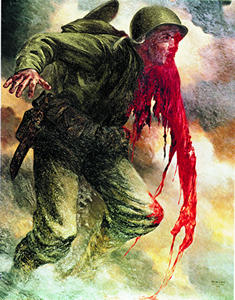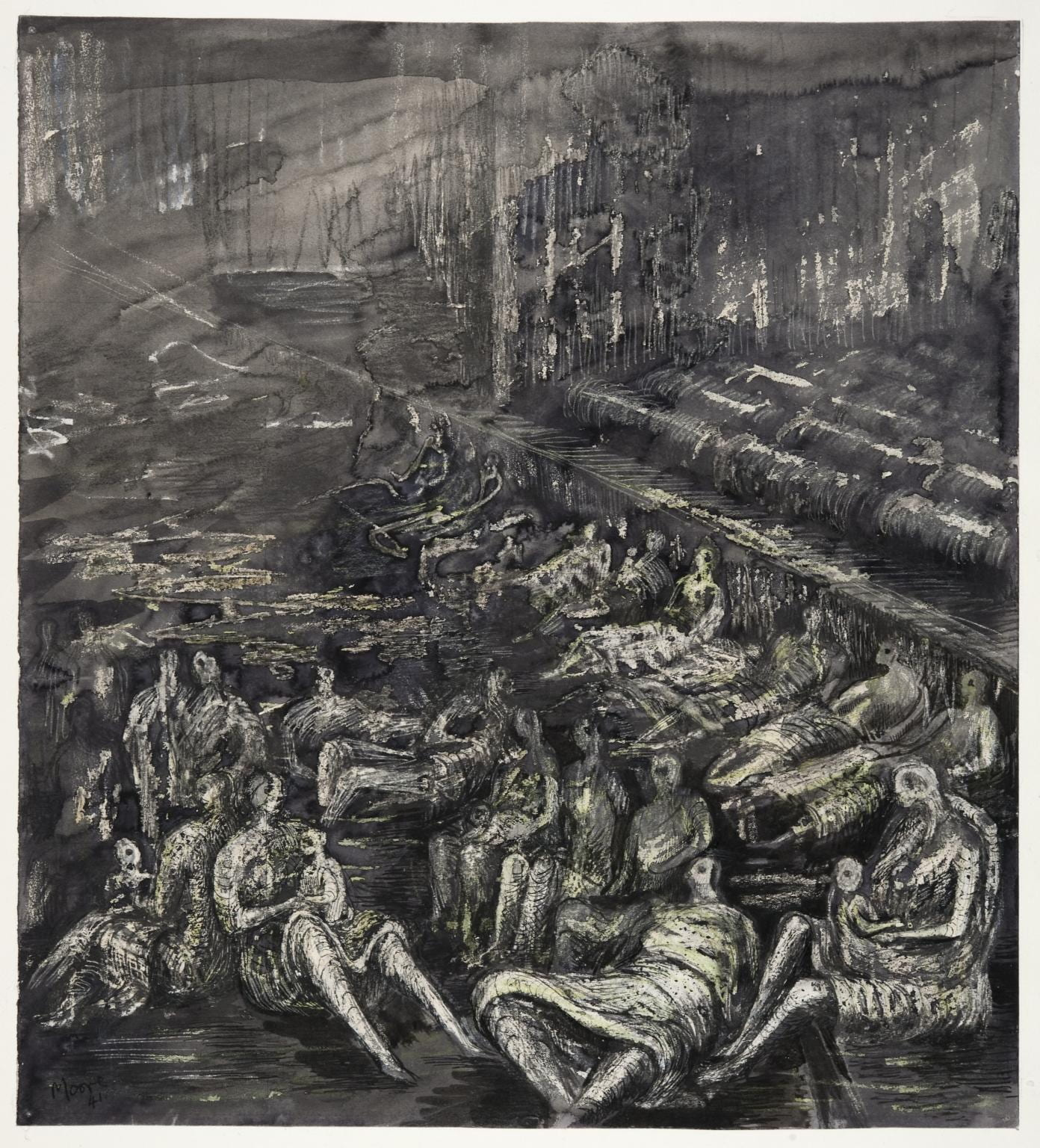The Influence of WWII on the Mid Modern Era Works of Art
A large majority of people were influenced by WWII and started to take a stand. Art works were not excluded from this. It was an opportunity to show what war was like and how it effected people all around the world. It even started showing the brutality and truth of war that was not typically seen by the common individual.
1944 Location: Depiction of Peleliu
1944 Location: Depiction of Peleliu
Tom Lea was a war art correspondent for Life Magazine. He originally attended the Art Institute of Chicago. After this he became a commercial artist in Chicago. In 1940 he accepted an invitation to work for LIFE Magazine. He covered the war for Life from 1941 to 1946. This put him in the direct viewing of the battle fields and you can feel this in is works. He painted and drew exactly what he had witnessed. His images are intended to show his first hand account viewings of WWII. These paintings have even hung in the Pentagon with the intention of reminding of the ugliness of war.
Elements
Color and contrast are greatly used in both paintings. There are many shades of green giving the aspect of dark conditions. In the painting The Price the only other color is red and it is made as the extreme contrast to draw immediate attention to it. The element of lines are curved and non defined giving strong sense of movement throughout both paintings. You can see this in the first painting showing soldiers throwing themselves while others lay limp having succumb to the fatalities of war. The second shows the soldier stumbling.
Placement
The painting Hitting the Beach makes all the soldiers the most important placement by them being in the immediate forefront of the painting. What the soldiers are falling to their deaths from are set far back making them less relevant. This painting is showing D-day and makes it clear with the placement that the focus is on the soldiers. The painting The Price has blatantly made the soldier the only object of interest by being front and center with no other items around. This painting was created to remind everyone the cost of battle.
Emotions
Both of these works are extremely emotion invoking. You can feel and sense the jumping to safety instinct that is shown in the first painting. You want to reach out and help them and try to protect them. The second painting is supposed to invoke strong emotion and was done well. You see this man is dying and there is nothing you can do. It makes you want to cry when you realize this was a real person that had their life ended in such a brutal way.
The Liverpool Street Extension
Created By: Henry Moore 1940-1941
Location: London
A Tilbury Shelter Scene 1941Created By: Henry Moore
Location: London
Henry Moore was a known sculpture in Britain. He was a soldier in the army in WWI. After that he would attend Leeds School of Art and the Royal College of Art. Ultimately, his drawings of London's community sheltering from the Blitz is what made him famous though. Henry did many drawings of the German aerial attacks on London starting in 1941. He was eventually asked to become an official war artist. What makes them so special is he is actually there with these individuals going through the Blitz while capturing what he witnessed. Moores' own home was bombed even.
Elements
These works involve a lot of shading and curved lines. Lighting is used throughout to create depth within the sketches. The shading gives a sense of collapsed and crammed bodies. At the same time the curves give individual outlines to each human being in these works. The lighting shows how dark these shelters were but also has just a hint enough of light to show the enormity of people sheltering.
Placement
The placement seems to portray that you are to look at the sketches as a whole. No one individual stands out more than another. They are all placed randomly crammed together and there are no strong individual details to draw you to one single person within the sketches.
Emotion
I find these sketches to be very raw with emotion. Even though you do not see faces and exact depictions of human beings you do see the children that are likely in hiding with their mothers and people crammed and huddled. You can feel the angst and stress of the conditions. The fear is strongly portrayed by how these individuals are cuddles so close together like them being close would make them safer.
Works Cited
“Biography.” Tom Lea Institute, 2020, www.tomlea.com/biography.
Christopher. St Thomas’ Hospital in Evacuation Quarters (1942), 4 Sept. 2012, evelyn-dunbar.blogspot.com/2012/09/st-thomas-hospital-in-evacuation.html.
“Evelyn Dunbar.” Never Such Innocence, www.neversuchinnocence.com/evelyn-dunbar-second-world-war. Accessed 21 Nov. 2023.
“Evelyn Dunbar.” Paint Drops Keep Falling, 13 Dec. 2011, paintdropskeepfalling.wordpress.com/2011/12/13/evelyn-dunbar/.
Hallett, Florence. “Henry Moore: The Artist in Wartime.” Henry Moore: The Artist in Wartime | The Tretyakov Gallery Magazine, 22 May 2020, www.tretyakovgallerymagazine.com/articles/1-2020-66/henry-moore-artist-wartime.
Klepper, Dan. “Tom Lea’s War.” Texas Co-Op Power, May 2019, texascooppower.com/tom-leas-war/.
Paul, Stella. “Abstract Expressionism: Essay: The Metropolitan Museum of Art: Heilbrunn Timeline of Art History.” The Met’s Heilbrunn Timeline of Art History, 1 Jan. 1AD, www.metmuseum.org/toah/hd/abex/hd_abex.htm.
Ucl. “The Tilbury Shelter.” The Survey of London The Tilbury Shelter Comments, blogs.ucl.ac.uk/survey-of-london/2020/04/17/the-tilbury-shelter/. Accessed 21 Nov. 2023.







Firstly, I like how your blog is organized, it was incredibly easy to read.
ReplyDeleteThere is a painting called "Goodbye Old Man' by Fortunino Matania that depicts a soldier hugging the head of his dying horse mid-bombing. That painting has always stuck with me, for the same reason that you feel strongly about the nurses depicted in your example paintings. I grew up with, and currently have, many horses. So, being able to tie myself into a depiction of war always makes my hair stand on end. That is why I find art to be so fascinating, because a common viewer like us can pull ourselves into the painting without even realizing it.
Hi Alicia. I think each of these give off sad and depressing vibes, which makes sense because they are about the second World War. The first two by Lea show how it seemed to be like during the war, they both show the harsh truth about how it was. The next two by Moore, I agree that you can feel the fear in them. Just seeing what people had to go through has a strong affect on me. The dark colors in both add to the distraught vibe. The last two by Dunbar do seem to be a bit brighter than the last four, mainly because of the coloring and the setting. I cannot imagine how busy the women must have been during that time period. Did you know for the painting called, "The Price" by Tom Lea was a man that he actually saw that looked like that? It seems like a sight like that would be unforgettable.
ReplyDeleteHi Alicia, I love all the war art pieces that you have selected for this project. I feel that they really do represent what was happening during this time. During World War 2, a lot of artworks were created their work in concentration camps.
ReplyDelete